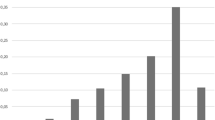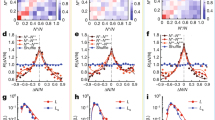Abstract
This paper examines whether commercial success in the popular recorded-music industry, as measured by gold-record output, conforms to an empirical concentration. We find that Lotka's Law overestimates the number of artists with one gold record and underestimates the number of multiplegold-record performing artists. However, for all measures of “successful” records, theGeneralized Lotka's Law provides an excellent fit, which suggests that the number of performers producingn gold records in about 1/n c of those producing one gold record.
Similar content being viewed by others
References
Baker, Alan J. (1991) “A Model of Competition and Monopoly in the Record Industry.”Journal of Cultural Economics 15: 29–54.
Belinfante, Alexander and Richard L. Johnson (1982) “Competition, Pricing and Concentration in the U.S. Recorded Music Industry.”Journal of Cultural Economics 6: 11–24.
Bookstein, Abraham (1977) “Patterns of Scientific Productivity and Social Change: A Discussion of Lotka's Law and Bibliometric Symmetry.”Journal of the American Society for Information Science 28: 206–210.
Cox, Raymond, A. K. and K. H. Chung (1991) “Patterns of Research Output and Author Concentration in the Economics Literature.”Review of Economics and Statistics 73: 740–747.
Dixit, Avinash K. and Joseph E. Stiglitz (1977) “Monopolistic Competition and Optimum Product Diversity.”American Economic Review 67: 297–308.
Hamlen, Jr., William A. (1991) “Superstardom in Popular Music: Empirical Evidence.”Review of Economics and Statistics 73: 729–733.
Lotka, Alfred J. (1926) “The Frequency Distribution of Scientific Productivity.”Journal of the Washington Academy of Sciences 16: 317–323.
MacDonald, Glenn M. (1988) “The Economics of Rising Stars.”American Economic Review 78: 155–167.
Mandelbrot, Benoit (1954) “Simple Games of Strategy Occurring in Communication through Natural Languages.”I.R.E. Transactions on Information Theory 3: 124–137.
Niles, Nathan O. and George E. Haborak (1971)Calculus with Analytic Geometry. Englewood Cliffs, New Jersey: Prentice-Hall.
Price, Derek J. deSolla (1976) “A General Theory of Bibliometric and Other Cumulative Advantage Processes.”Journal of the American Society for Information Science 27: 292–306.
Rosen, Sherwin (1981) “The Economics of Superstars.”American Economic Review 71: 845–858.
Schorr, Alan E. (1975) “Lotka's Law and Map Librarianship.”Journal of the American Society for Information Science 26: 189–190.
Simon, Herbert A. (1955) “On a Class of Skew Distribution Functions.”Biometrika 42: 425–440.
Stambler, Irwin (1989)The Encyclopedia of Pop Rock and Soul. St. Martin's Press, New York, New York.
Subramanyam, K. (1979) “Lotka's Law and the Literature of Computer Science.”IEEE Transactions on Professional Communication, PC-22, December 1979, pp. 187–189.
Author information
Authors and Affiliations
Rights and permissions
About this article
Cite this article
Cox, R.A.K., Felton, J.M. & Chung, K.H. The concentration of commercial success in popular music: An analysis of the distribution of gold records. J Cult Econ 19, 333–340 (1995). https://doi.org/10.1007/BF01073995
Issue Date:
DOI: https://doi.org/10.1007/BF01073995




